
Restaurants can’t succeed without quality ingredients, top-notch facilities, and supportive staff. But recent upheaval following the COVID-19 pandemic has led to restaurants worldwide struggling to find these vital resources.
However, restaurant owners like Jonathan Sears of SC are proving they’re an innovative bunch. There are many great ways that these entrepreneurs have helped their businesses get through these trying times.
We’ve put together a list of the most pressing issues for those in the hospitality industry and inventive ways restaurants have dealt with the problems.
Labor Shortages
2021 has been a hard year for everyone in the restaurant industry – including employees. Many hospitality venues have been unable to open regularly, leading many who previously worked in the industry to seek new jobs. The media has referred to this phenomenon as the ‘Great Resignation.’
Although this may be a savvy financial decision for workers, it can be a disaster for the restaurants they have left behind. Now that hospitality businesses are back open, and there’s a high demand from customers for service, more staff are needed to work. However, very few are available.
This hasn’t stopped restaurant owners, however. Many are finding the situation gives them an opportunity to improve their staff relations, ensuring that existing staff feel valued as part of a drive towards improving retention levels in the hospitality sector.
In addition, some restaurateurs have even looked at streamlining and automating elements of the restaurant experience to save on labor costs, such as ordering through an app instead of via a waiter or offering self-service drinks facilities.
Supply Chain Breakdown
Labor shortages don’t just affect restaurants and bars directly. For example, there is a current shortage of drivers in both America and the UK, meaning that it’s hard for ingredients and condiments to be delivered to restaurants and bars. This breakdown in the supply chain can have disastrous consequences.
All hospitality venues need supply chain to work more efficiently to stay open. This leaves business owners in a difficult situation – should they close and lose potential business or pay huge cost increases?
It is possible to find a silver lining in this situation. Many restaurant owners have found that recent issues have given them the push they need to invest in a more sustainable supply chain. Not only will purchasing products from their local areas lead to fewer delays in shipping and delivery, but it’s also a great way to help the local community and the environment. Fewer miles traveled by suppliers means less pollution – a win for everyone.
Restaurant Material Shortages
Consumers often forget how vital materials are to a restaurant. Its hugely important that any service has what it needs to prepare its goods – and food supply chains are no exception.
Recent months have seen steep hikes in the price of necessary materials – including plywood, cleaning supplies, disposable cutlery, and even cooking equipment. Furthermore, changes to the recent labor market have seen factories halting or reducing production – or sometimes even shutting down altogether.
There’s no denying that this makes the life of restaurant owners and managers extremely difficult at times. However, small businesses have found ways to pull through. Many have evolved drastically to keep running – from completely changing their layouts to switching suppliers to greener alternatives.
Although the current situation is unpredictable, it’s clear that restaurant owners aren’t giving up without a fight.
Food Shortages
At the heart of any successful restaurant is great food. However, restaurants across the world have struggled to find the necessary ingredients to keep their menus going. This is particularly challenging for restaurants that rely on rare supplies or non-domestic imports.
The most common way that restaurants have dealt with this problem is by adapting their menu. Once again, locally sourced produce is often the solution to this issue. They’re much easier to get ahold of and offer the bonus of helping the local community.
However, this is not always an option for restaurants. Those serving a specialized cuisine cannot suddenly change to food that is based on their local area. Instead, many have opted to rationalize their menus to save on the costs to import. In this way, they can continue to serve the most popular dishes – customers just need to arrive early before items sell out that night.
A Continual Process of Adaptation
Running a restaurant was never going to be an easy task in a pandemic. However, there’s no denying that changes in the economy and political situations across the globe have added some unpredictable challenges in the past few years. This has led to supply chain issues and shortages in labor, food, and materials.
However, restaurant owners don’t give up easily. There are thousands of stories of businesses fighting back with resilience and innovation. Although the world hasn’t yet recovered from its recent struggles, it’s clear that restaurant owners are doing everything they can to keep their customers and staff satisfied and safe.




